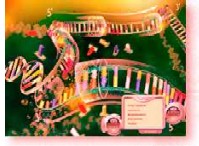(Latin: replicare = to repeat)
Prior to a division of cells, the DNA strand in the cell nucleus has to be duplicated so that both cells contain the complete genetic information after the division.
 | |
|
Prior to the duplication, the DNA rope ladder, which is normally twisted, is partially uncoiled. The two strands of the DNA rope ladder, normally connected by two respective letters (bases) which form rungs, are separated so that two single chains of base letters are existent. The copying device, a protein, now moves along the two single strands and builds the two additional single strands from DNA letters which are floating about in the cell nucleus.
The copying device is called DNA polymerase because it generates an exact copy of the former strand partner from many DNA base letters (Greek: poly = many, meros = part). The decision which base letter is to be connected next is made very easy for the DNA polymerase, because each base letter of the DNA strand fits with only one of four possible partners, e.g. Cytosine fits with Guanine or Adenine fits with Thymine . With one of the other three base letters, too long, too short or crooked “rungs” would be generated in the DNA rope ladder. Therefore, the order of the gene letters on one strand inevitably specifies the order of gene letters on the other. That means that if a DNA thread is unzipped, each half of it can be used as a template to recreate a whole double strand identical to the original.
Thus from two single strands, two double strands come into existence. Scientists call this kind of DNA replication “semi-conservative” because half of the duplicated DNA molecules consist of an old and half of them consist of a new strand. This replication happens every time a cell divides. It is the core of life’s operating system.